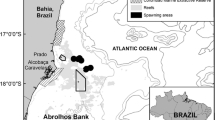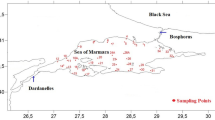Abstract
Little is known about the giant devil ray (Mobula mobular), an endangered species endemic to the Mediterranean. Gaza is the only region where this species is targeted, hence, this fishery was studied to address the knowledge gap on fishery interactions, species behavior, and life-history traits. Devil rays have been frequenting this maritime area for at least the past 50 years for a short window from February to April. Landings are reported from 2005 to 2016, along with disc-width (DW) measurements for recent years. A total of 304 M. mobular (over 90% males) were landed in Gaza from 2014 to 2016, most which were mature and appeared to be mating (over 90% of males had sperm-filled claspers), providing critical insight that this area may serve as a mating ground. Yearly landings are shown here to closely match the allowed fishing distance from shore, which changes regularly, indicating that the rays are normally caught between 6 and 12 n.m. offshore. Width-weight conversion parameters are calculated for the first time for this species: a = 2.68 × 10−6 and b = 4.39. Fresh protein drives this local fishery, as food security is a major issue. An export market for gill plates was reported intermittently, and is no longer possible due to strict trade restrictions. We highlight the lack of awareness of fishers regarding the IUCN’s Red List ‘Endangered’ status of devil rays, and stress the urgent need for national protection of this species, particularly due to the species’ very slow life-history traits and probable usage of this area as a mating ground.






Similar content being viewed by others
References
Abudaya M, Harper S, Ulman A, Zeller D (2014) Correcting mis- and under-reported marine fisheries catches for the Gaza Strip: 1950–2010. Acta Adriat 54:241–252
Akyol O, Erdem M, Unal V, Ceyhan T (2005) Investigations on drift-net fishery for swordfish (Xiphias gladius L.) in the Aegean Sea. Turk J Vet Anim Sci 29:1225–1231
Bigelow HB, Schroeder WC (1953) Sharks, sawfishes, guitarfishes, skates and rays, chimaeroids. In: Tee-van J, Breder CM, Hildebrand SF, Parr AE, Schroeder We (eds) Fishes of the western north Atlantic. Part 2. Sears foundation for marine research, Yale University, New Haven, pp 1–514
Boero F, Carli A (1979) Catture di Elasmobranchi nella tonnarella di Camogli (Genova) dal 1950 al 1974. Bol Mus Ist Biol Univ Genova 47:27–34
Bradai MN, Capapé C (2001) Captures du diable de mer, Mobula mobular, dans le Golfe de Gabés (Tunisie meridionale, Méditerranée centrale. Cybium 25:389–391
Canese S, Cardinali A, Romeo T, Giusti M, Salvati E, Angiolillo M, Greco S (2011) Diving behavior of the giant devil ray in the Mediterranean Sea. Endanger Species Res 14:171–176
Capapé C, Rafrafi-Nouira S, El Kamel-Moutalibi O, Boumaiza M, Reynaud C (2015) First Mediterranean records of spinetail devil ray Mobula japanica (Elasmobranchii: Raijformes: Mobulidae). Acta Ichthyol Piscat 45:211–215
Celona A (2004) Caught and observed giant devil rays Mobula mobular (Bonnaterre 1788) in the Strait of Messina. Ann Ser Hist Nat 14:11–18
Couturier LIE et al (2012) Biology, ecology and conservation of the Mobulidae. J Fish Biol 80:1075–1119. doi:10.1111/j.1095-8649.2012.03264.x
Croll DA et al (2016) Vulnerabilities and fisheries impacts: the uncertain future of manta and devil rays. Aquat Conserv Mar Freshw Ecosyst 26:562–575. doi:10.1002/aqc.2591
Duell M (2013) Mystery of the massacred mobula rays: just why did dozens of these bloodied sea creatures wash up on the beach in Gaza? London, UK. http://www.dailymail.co.uk/news/article-2285463/Dozens-mobula-rays-washed-Gaza-beach-collected-fishermen-carted-market.html
Dulvy NK et al (2008) You can swim but you can’t hide: the global status and conservation of oceanic pelagic sharks and rays. Aquat Conserv Mar Freshw Ecosyst 18:459–482. doi:10.1002/aqc.975
Dulvy NK et al (2014) Extinction risk and conservation of the world’s sharks and rays. eLife 3:e00590
Ebert DA, Stehmann M (2013) Sharks, batoids, and chimaeras of the North Atlantic, vol 7. FAO, Rome
Fernandes P, Ralph G, Nieto A, Criado M, Vasilakopoulos P, Maravelias C, Cook RM, Pollom RA, Kovačić M, Pollard D, Farrell ED, Florin A-N, Polidoro BA, Lawson JM, Lorance P, Uiblein F, Craig M, Allen DJ, Fowler SL, Walls RHL, Comeros-Raynal MT, Harvey MS, Dureuil M, Biscoito M, Pollock C, Phillips SRM, Ellis JR, Papaconstantinou C, Soldo A, Keskin C, Knudsen SW, de Sola LG, Serena F, Collette BB, Nedreaas K, Stump E, Russell BC, Garcia S, Afonso P, Jung ABJ, Alvarez H, Delgado J, Dulvy NK, Carpenter KE (2017) Coherent assessments of Europe’s marine fishes show regional divergence and megafauna loss. Nat Ecol Evol 1(0170):9
Ferretti F, Myers RA, Serena F, Lotze HK (2008) Loss of large predatory sharks from the Mediterranean Sea. Conserv Biol 22:952–964. doi:10.1111/j.1523-1739.2008.00938.x
Fortuna C, Kell L, Holcer D, Canese S, Filidei E Jr., Mackelworth P, Donovan G (2014) Summer distribution and abundance of the giant devil ray (Mobula mobular) in the Adriatic Sea: baseline data for an iterative management framework. Sci Mar 78:227–237
Froese R (2006) Cube law, condition factor and weight–length relationships: history, meta-analysis and recommendations. J Appl Ichthyol 22:241–253. doi:10.1111/j.1439-0426.2006.00805.x
Graham RT, Witt MJ, Castellanos DW, Remolina F, Maxwell S, Godley BJ (2012) Satellite tracking of manta rays highlights challenges to their conservation. PLoS ONE 7(5):e36834
Hemida F, Mehezem S, Capapé C (2002) Captures of the giant devil ray Mobula mobular Bonnaterre, 1788 (Chondrichthyes: Mobulidae) off the Algerian coast (southern Mediterranean). Acta Adriat 43:69–76
Holcer D, Lazar B, Mackelworth P, Fortuna CM (2013) Rare or just unknown? The occurrence of the giant devil ray (Mobula mobular) in the Adriatic Sea. J Appl Ichthyol 29:139–144. doi:10.1111/jai.12034
Lawson J, Fordham S, O’Malley M, Davidson L, Walls RHL, Heupel MR, Stevens G, Fernando D, Budziak A, Simpfendorfer CA, Ender I, Francis MP, di Sciara GN, Dulvy NK (2017) Sympathy for the devil: a conservation strategy for devil and manta rays. PeerJ 5:e3027. doi:10.7717/peerj.3027
Marano G, Vaccarella R, Bello G, Pastorelli AM (1983) Prime osservazioni sulla pesca di Xiphias gladius L. (Osteichthyes) nel Basso Adriatico. Thalass Salentina 12/13:50–59
MEDEA Occupied Palestinian Territories. MEDEA-Europen Institute for Research on Euro-Arab Cooperation. http://www.medea.be/en/countries/occupied-palestinian-territories/oslo-peace-process/. Accessed 12 Feb 2016
Melon M (2011) Shifting paradigms: report on Israel’s enforcement of the buffer zone in the Gaza Strip. Al-Haq and Palestinian National Authority, Ramallah
Muñoz-Chapuli R, Notarbartolo di Sciara G, Séret B, Stehmann M (1993) The status of the elasmobranch fisheries in Europe. IUCN, Gland
Nieto A, Ralph G, Comeros-Raynal M et al (2015) European Red List of marine fishes. European Commission: IUCN Global Species Programme, IUCN European Regional Office, Belgium, p 90
Northridge SP (1991) Driftnet fisheries and their impacts on non-target species: a worldwide review. FAO, Rome
Notarbartolo di Sciara G (1987) A revisionary study of the genus Mobula Rafinesque, 1810 (Chondrichthyes, Mobulidae), with the description of a new species. Zool J Linn Soc 91:1–91
Notarbartolo di Sciara and Serena (1988) Term embryo of Mobula (Bonnaterre, 1788) from the northern Tyrrhenian Sea (Chondrichthyes: Mobulidae). Atti Soc Ital Sci Nat Museo Civ Stor Nat Milano 129(4):396–400
Notarbartolo di Sciara G, Lauriano G, Pierantonio N, Canadas A, Donovan G, Panigada S (2015a) The devil we don’t know: investigating habitat and abundance of endangered giant devil rays in the North-Western Mediterranean Sea. PLoS ONE 10:e0141189. doi:10.1371/journal.pone.0141189
Notarbartolo di Sciara G, Serena F, Mancusi C (2015b) Mobula mobular. The IUCN Red List of threatened species 2015 e.T39418A48942228
O’Malley M, Townsend KA, Hilton P, Heinrichs S, Stewart JD (2016) Characterization of the trade in manta and devil ray gill plates in China and South-east Asia through trader surveys. Aquat Conserv Mar Freshw Ecosyst 20. doi:10.1002/aqc.2670
Orsi Relini L, Cima C, Garibaldi F, Palandri G, Relini M, Torchia G (1999) La pesca professionale con i palamiti galleggianti nel ‘Santuario dei Cetacei’ del Mar Ligure: si tratta di attività ecocompatibili? Biol Mar Mediterr 1999:100–109
Pardo SA, Kindsvater HK, Cuevas-Zimbrón E, Sosa-Nishizaki O, Pérez-Jiménez JC, Dulvy NK (2016) Growth, productivity, and relative extinction risk of a data-sparse devil ray. Sci Rep 6:33745. doi:10.1038/srep33745
R Development Core Team (2006) R: A language and environment for statistical computing. R foundation for statistical computing, Vienna, Austria. http://www.R-project.org
Rafrafi-Nouira S, El Kamel-Moutalibi O, Ben Amor MM, Capapé C (2015) Additional records of spinetail devil ray Mobula japanica (Chondrichthyes: Mobulidae) from the Tunisian coast (Central Mediterranean). Annales 25:103–108
Sakalli A, Yucel N, Capapé C (2016) Confirmed occurrence in the Mediterranean Sea of Mobula japanica (Müller and Henle 1841) with a first record off the Turkish coasts. J Appl Ichthyol. doi:10.1111/jai.13218
Scacco U, Consalvo I, Mostarda E (2009) First documented catch of the giant devil ray Mobula mobular (Chondrichthyes: Mobulidae) in the Adriatic Sea. Mar Biodiv Rec 2:e93. doi:10.1017/S1755267209001110
Storai T, Zinzula L, Repetto S, Zuffa M, Morgan A, Mandelman J (2011) Bycatch of large elasmobranchs in the traditional tuna traps (tonnare) of Sardinia from 1990 to 2009. Fish Res 109:74–79
The World Bank (2015) Gaza economy on the verge of collapse, youth unemployment highest in the region at 60 percent. http://www.worldbank.org/en/news/press-release/2015/05/21/gaza-economy-on-the-verge-of-collapse. Accessed 12 Nov 2016
Acknowledgements
We thank the Save Our Seas Foundation for funding this study from 2013 to 2014 and the MAVA Foundation for funding the study from 2015 to 2016.
Author information
Authors and Affiliations
Corresponding authors
Electronic supplementary material
Below is the link to the electronic supplementary material.
Rights and permissions
About this article
Cite this article
Abudaya, M., Ulman, A., Salah, J. et al. Speak of the devil ray (Mobula mobular) fishery in Gaza. Rev Fish Biol Fisheries 28, 229–239 (2018). https://doi.org/10.1007/s11160-017-9491-0
Received:
Accepted:
Published:
Issue Date:
DOI: https://doi.org/10.1007/s11160-017-9491-0




